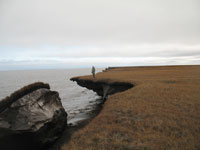Sea Level Rise: Coastal Bluff Erosion in the Arctic

Lead author Dr. Benjamin Jones, above, measures erosion along part of Alaska’s Arctic coast. A collapsed block of ice-rich permafrost is shown on bottom left. Photograph by Christopher Arp, USGS.
Integral Principal Craig Jones, Ph.D., is coauthor of a paper published in Environmental Research Letters, titled “A decade of remotely sensed observations highlight complex processes linked to coastal permafrost bluff erosion in the Arctic.”
In the paper, lead author Benjamin Jones, Ph.D., of the University of Alaska, and his coauthors describe a study that used satellite imagery acquired from 2008 to 2017 to observe changes in a segment of coastline at Drew Point, Alaska. Results show that mean annual erosion for the 2007–2016 decade was 17.2 meters per year, which is 2.5 times faster than historical rates, indicating that bluff erosion at this site is likely responding to changes in the Arctic System. These changes include declining sea ice, rising sea levels, warmer summer sea-surface temperatures, and increases in storm power and wave action.
Environmental Research Letters covers all of environmental science, providing a coherent and integrated approach including research articles, perspectives, and review articles. Citation: Benjamin M Jones et al. 2018 Environ. Res. Lett. 13 11500.
Dr. Craig Jones is a principal ocean and environmental engineer with 20 years of experience in developing and executing engineering and science projects for government agencies and the private sector to characterize offshore environmental sites. His experience includes riverine, lacustrine, estuarine, and coastal processes involving hydrodynamics, waves, sediment, and contaminant transport. For more information, contact Dr. Jones at cjones@integral-corp.com.

